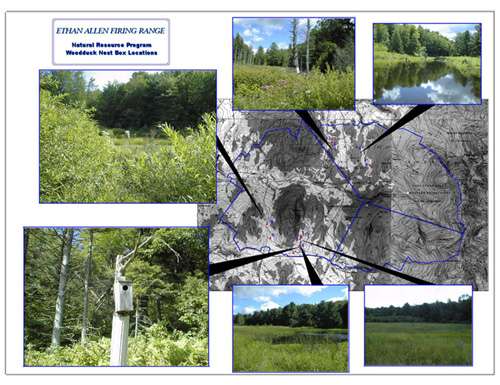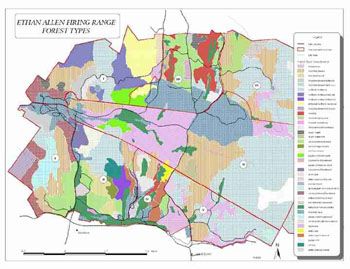With over 14,000 acres of land including Ethan Allen Firing Range in Jericho, and Camp Johnson, in Colchester, the Vermont Military Department is the steward of a wide variety of natural resources. The mission of the Military Department is to provide support to the Vermont National Guard in providing quality-training opportunities for its soldiers. Part of that mission includes sound management of the natural resources in these areas for continued training opportunities for the future.
The office uses a contract forester and wildlife biologist to assist in issues regarding the conservation, management, and restoration of land and renewable resources in support of the military mission and in compliance with applicable state and federal regulations. Forest management is done under the multiple use concept which provides for timber harvesting, wildlife habitat, soil stabilization, and watershed and wetland protection. A project is underway to map state controlled wetlands. Work also continues by the Vermont Non-Game and Natural Heritage Program to reestablish a healthy Pitch Pine community on Camp Johnson in Colchester.
Training sites must provide military troops with the training needed to win wars and protect our nation. Impacts of training must be minimized and/or mitigated to maintain the carrying capacity of these training sites. The military must plan training activities so they do not negatively affect the people, lands, or resources surrounding training sites or the training sites themselves.
As part of this stewardship, all National Guard training lands must prepare Integrated Natural Resource Management Plans (INRMP), to help ensure sound land management and compliance with relevant state and federal regulations. Consultation with the public, and other state and federal agencies including the U.S. Fish and Wildlife Service and the Vermont State Department of Natural Resources, will help insure the best plan possible. The Military Department is currently developing a new 5-year plan that will be ready for public and agency review in the near future. Included in these plans are wetlands management, threatened and endangered species management, forestry and vegetation management plans, as well as habitat improvement and research programs.
Wildlife
 The goals of the Wildlife program are to manage, conserve, protect, and provide fish and wildlife habitat on State of Vermont Military Lands in a manner that assures the perpetuation of species present today and allows for recolonization of extirpated species. Some of the objectives of the program are: to identify and protect individuals and/or populations of sensitive, threatened or endangered fish and wildlife species and their habitats and to identify and protect unique, limited, or critical areas of wildlife habitat for species of special concern; to improve ecosystem health; to ensure natural resource management and military training are accomplished concurrently; and to manage natural resources in coordination with other state and federal agencies.
The goals of the Wildlife program are to manage, conserve, protect, and provide fish and wildlife habitat on State of Vermont Military Lands in a manner that assures the perpetuation of species present today and allows for recolonization of extirpated species. Some of the objectives of the program are: to identify and protect individuals and/or populations of sensitive, threatened or endangered fish and wildlife species and their habitats and to identify and protect unique, limited, or critical areas of wildlife habitat for species of special concern; to improve ecosystem health; to ensure natural resource management and military training are accomplished concurrently; and to manage natural resources in coordination with other state and federal agencies.
Annual surveys are currently being conducted for threatened and endangered species, as well as tracking and spotlight surveys for the censusing of large mammals. Waterfowl breeding surveys are also conducted annually to index breeding populations of non-cavity nesting waterfowl species and to index total potential populations of non-cavity nesting waterfowl species. Waterfowl nest boxes are also checked in winter, and egg shell fragments identified to species. Several other wildlife surveys are conducted annually or at least biennially.
Special Projects
Woodcock Mortality Study
A woodcock mortality study was conducted during August - December 1998 on the Ethan Allen Firing Range. Fifty woodcock were captured; forty-five birds of which were radio-marked. This is part of a larger regional woodcock mortality study, and will continue in the summer and fall of 1999.
Ethan Allen Nature Trail
The Vermont Army National Guard is developing a Children's Nature Trail. This trail will be in a remote, non-shooting part of the Ethan Allen Firing Range. Its use would be exclusively by school groups with grades 1-2 and 5-6 as the intended audience. The plan is to create pre-trip material, brochures or signs interpreting the trail and follow up material to be used back at school. Use of the trail would be through reservation only. The emphasis on the trail would be a description of tree species and their habitats as well as the wildlife that you may expect to encounter in each of them. Natural disturbances and historic uses will also be touched upon during the nature walk.
Forestry
Ethan Allen Firing Range
 Forest Management plays a crucial role in sustaining the long term viability and carrying capacity of training lands on the firing range. Pro-active management maintains and promotes a healthy and diverse forest ecosystem. Selective thinning in appropriate areas helps to keep healthy and vigorous stands of both hardwoods and softwoods. In areas between 1200-1800 feet in elevation, emphasis will be on a normal distribution of ages of forest stands that provide an optimal sustained supply of habitat ranging from early to late successional stage. Northern hardwood stands will be managed on a 120-year rotation with an emphasis on a mix of even and uneven-aged stands.
Forest Management plays a crucial role in sustaining the long term viability and carrying capacity of training lands on the firing range. Pro-active management maintains and promotes a healthy and diverse forest ecosystem. Selective thinning in appropriate areas helps to keep healthy and vigorous stands of both hardwoods and softwoods. In areas between 1200-1800 feet in elevation, emphasis will be on a normal distribution of ages of forest stands that provide an optimal sustained supply of habitat ranging from early to late successional stage. Northern hardwood stands will be managed on a 120-year rotation with an emphasis on a mix of even and uneven-aged stands.
The belt of northern hardwoods between 1400' - 1800' elevation is critical to many wildlife species, including black bear. Several other species such as lynx and marten would also benefit from a lack of human intrusion and the abundance of climax vegetation types. These areas will be left as they are. The forest management program will continue to monitor the successional changes that are occurring in these areas.
Download PDF version of Forest Types Map
Camp Johnson
Camp Johnson, located in Colchester, is on one of the rarest natural community types in Vermont - the pine/oak/heath sandplain forest. Pitch pine growing in the Champlain Valley of Vermont are at the northern extreme of the species' natural range which extends from central Maine to northern Georgia. Marginal populations, such as those found in the Champlain Valley, are often genetically unique compared to more central populations and, therefore, may be valuable for future adaptation and evolution of the species, especially in times of predicted rapid climate change. Pitch pine in the northern extreme of the species range commonly compete best and are found on acidic, sandy, sterile soils in association with gray birch, red oak and black oak. In the Champlain Valley, particularly in the Burlington area, these same sites are extremely valuable as building sites. As a result, pitch pine habitat and populations are shrinking in response to development pressure.
Camp Johnson is one of the few remaining sites of pitch pine populations in Vermont. This tract supports a population of about 200-300 mature pitch pine growing primarily in small groups. There is very little regeneration in these stands, probably due to poor establishment conditions for young pitch pine seedlings. Pitch pine in this area usually require periodic fires to remove competition and prepare seed beds for germination and seedling establishment. Over the past 100 years humans have extinguished fires in this area for fear of it spreading to residential and commercial buildings along the fringes of Camp Johnson.
In 1995, the Nongame and Natural Heritage Program staff completed two prescribed burns at Camp Johnson to remove competition and prepare seed beds for pitch pine establishment. The scarcity of pitch pine habitat in Vermont along with lack of adequate natural regeneration in the tract at Camp Johnson, has prompted Nongame and Natural Heritage Program staff in conjunction with Camp Johnson personnel to make several pitch pine seedling plantings in these burned over areas on the base.
Since 1995, a couple of burning and planting cycles have taken place, along with the mechanical clearing of several small areas to create more openings for pitch pine seedling regeneration. These open areas will also be burned prior to the planting of seedlings. The condition of the pitch pine community will continue to be monitored by the Nongame and Natural Heritage Program and Camp Johnson staff in the coming years to successfully restore and maintain this rare natural community.

